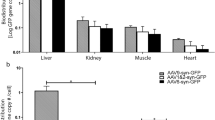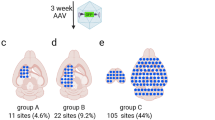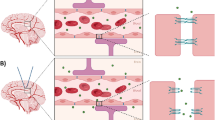Abstract
Non-invasive gene delivery across the blood–spinal cord barrier (BSCB) remains a challenge for treatment of spinal cord injury and disease. Here, we demonstrate the use of magnetic resonance image-guided focused ultrasound (MRIgFUS) to mediate non-surgical gene delivery to the spinal cord using self-complementary adeno-associated virus serotype 9 (scAAV9). scAAV9 encoding green fluorescent protein (GFP) was injected intravenously in rats at three dosages: 4 × 108, 2 × 109 and 7 × 109 vector genomes per gram (VG g−1). MRIgFUS allowed for transient, targeted permeabilization of the BSCB through the interaction of focused ultrasound (FUS) with systemically injected Definity lipid-shelled microbubbles. Viral delivery at 2 × 109 and 7 × 109 VG g−1 leads to robust GFP expression in FUS-targeted regions of the spinal cord. At a dose of 2 × 109 VG g−1, GFP expression was found in 36% of oligodendrocytes, and in 87% of neurons in FUS-treated areas. FUS applications to the spinal cord could address a long-term goal of gene therapy: delivering vectors from the circulation to diseased areas in a non-invasive manner.
This is a preview of subscription content, access via your institution
Access options
Subscribe to this journal
Receive 12 print issues and online access
$259.00 per year
only $21.58 per issue
Buy this article
- Purchase on Springer Link
- Instant access to full article PDF
Prices may be subject to local taxes which are calculated during checkout







Similar content being viewed by others
References
Goins WF, Cohen JB, Glorioso JC . Gene therapy for the treatment of chronic peripheral nervous system pain. Neurobiol Dis 2012; 48: 255–270.
Romero MI, Rangappa N, Garry MG, Smith GM . Functional regeneration of chronically injured sensory afferents into adult spinal cord after neurotrophin gene therapy. J Neurosci 2001; 21: 8408–8416.
Nagahara AH, Tuszynski MH . Potential therapeutic uses of BDNF in neurological and psychiatric disorders. Nat Rev Drug Discov 2011; 10: 209–219.
Passini MA, Bu J, Roskelley EM, Richards AM, Sardi SP, O’Riordan CR et al. CNS-targeted gene therapy improves survival and motor function in a mouse model of spinal muscular atrophy. J Clin Invest 2010; 120: 1253–1264.
Foust KD, Wang X, McGovern VL, Braun L, Bevan AK, Haidet AM et al. Rescue of the spinal muscular atrophy phenotype in a mouse model by early postnatal delivery of SMN. Nat Biotechnol 2010; 28: 271–274.
Bevan AK, Duque S, Foust KD, Morales PR, Braun L, Schmelzer L et al. Systemic gene delivery in large species for targeting spinal cord, brain, and peripheral tissues for pediatric disorders. Mol Ther 2011; 19: 1971–1980.
Meyer K, Ferraiuolo L, Schmelzer L, Braun L, McGovern V, Likhite S et al. Improving single injection CSF delivery of AAV9-mediated gene therapy for SMA: a dose-response study in mice and nonhuman primates. Mol Ther 2014; 23: 477–487.
Lepore AC, Haenggeli C, Gasmi M, Bishop KM, Bartus RT, Maragakis NJ et al. Intraparenchymal spinal cord delivery of adeno-associated virus IGF-1 is protective in the SOD1G93A model of ALS. Brain Res 2007; 1185: 256–265.
Reese TS, Karnovsky MJ . Fine structural localization of a blood-brain barrier to exogenous peroxidase. J Cell Biol 1967; 34: 207–217.
Pardridge WM . Blood-brain barrier delivery. Drug Discov Today 2007; 12: 54–61.
Hynynen K, McDannold N, Vykhodtseva N, Jolesz FA . Noninvasive MR imaging-guided focal opening of the blood-brain barrier in rabbits. Radiology 2001; 220: 640–646.
Sheikov N, McDannold N, Sharma S, Hynynen K . Effect of focused ultrasound applied with an ultrasound contrast agent on the tight junctional integrity of the brain microvascular endothelium. Ultrasound Med Biol 2008; 34: 1093–1104.
Zhang Z, Xue Y, Liu Y, Shang X . Additive effect of low-frequency ultrasound and endothelial monocyte-activating polypeptide II on blood-tumor barrier in rats with brain glioma. Neurosci Lett 2010; 481: 21–25.
Fan L, Liu Y, Ying H, Xue Y, Zhang Z, Wang P et al. Increasing of blood-tumor barrier permeability through paracellular pathway by low-frequency ultrasound irradiation in vitro. J Mol Neurosci 2011; 43: 541–548.
Xia CY, Zhang Z, Xue YX, Wang P, Liu YH . Mechanisms of the increase in the permeability of the blood-tumor barrier obtained by combining low-frequency ultrasound irradiation with small-dose bradykinin. J Neurooncol 2009; 94: 41–50.
Deng J, Huang Q, Wang F, Liu Y, Wang Z, Wang Z et al. The role of caveolin-1 in blood-brain barrier disruption induced by focused ultrasound combined with microbubbles. J Mol Neurosci 2012; 46: 677–687.
Hynynen K, McDannold N, Vykhodtseva N, Raymond S, Weissleder R, Jolesz FA et al. Focal disruption of the blood-brain barrier due to 260-kHz ultrasound bursts: a method for molecular imaging and targeted drug delivery. J Neurosurg 2006; 105: 445–454.
Kinoshita M, McDannold N, Jolesz FA, Hynynen K . Targeted delivery of antibodies through the blood-brain barrier by MRI-guided focused ultrasound. Biochem Biophys Res Commun 2006; 340: 1085–1090.
Raymond SB, Treat LH, Dewey JD, McDannold NJ, Hynynen K, Bacskai BJ . Ultrasound enhanced delivery of molecular imaging and therapeutic agents in Alzheimer’s disease mouse models. PLoS One 2008; 3: e2175.
Jordao JF, Ayala-Grosso CA, Markham K, Huang Y, Chopra R, McLaurin J et al. Antibodies targeted to the brain with image-guided focused ultrasound reduces amyloid-beta plaque load in the TgCRND8 mouse model of Alzheimer’s disease. PLoS One 2010; 5: e10549.
Thevenot E, Jordao JF, O’Reilly MA, Markham K, Weng YQ, Foust KD et al. Targeted delivery of self-complementary adeno-associated virus serotype 9 to the brain, using magnetic resonance imaging-guided focused ultrasound. Hum Gene Ther 2012; 23: 1144–1155.
Grimm D, Kay MA . From virus evolution to vector revolution: use of naturally occurring serotypes of adeno-associated virus (AAV) as novel vectors for human gene therapy. Curr Gene Ther 2003; 3: 281–304.
Burgess A, Ayala-Grosso CA, Ganguly M, Jordao JF, Aubert I, Hynynen K . Targeted delivery of neural stem cells to the brain using MRI-guided focused ultrasound to disrupt the blood-brain barrier. PLoS One 2011; 6: e27877.
Chen L, Mu Z, Hachem P, Ma CM, Wallentine A, Pollack A . MR-guided focused ultrasound: enhancement of intratumoral uptake of [(3)H]-docetaxel in vivo. Phys Med Biol 2010; 55: 7399–7410.
Jordao JF, Thevenot E, Markham-Coultes K, Scarcelli T, Weng YQ, Xhima K et al. Amyloid-beta plaque reduction, endogenous antibody delivery and glial activation by brain-targeted, transcranial focused ultrasound. Exp Neurol 2013; 248: 16–29.
Scarcelli T, Jordao JF, O’Reilly MA, Ellens N, Hynynen K, Aubert I . Stimulation of hippocampal neurogenesis by transcranial focused ultrasound and microbubbles in adult mice. Brain Stimul 2014; 7: 304–307.
Burgess A, Dubey S, Yeung S, Hough O, Eterman N, Aubert I et al. Alzheimer’s disease in a mouse model: MR imaging-guided focused ultrasound targeted to the hippocampus opens the blood-brain barrier and improves pathologic abnormalities and behavior. Radiology 2014; 273: 736–745.
Fry FJ, Barger JE . Acoustical properties of the human skull. J Acoust Soc Am 1978; 63: 1576–1590.
Kaufman JJ, Einhorn TA . Ultrasound assessment of bone. J Bone Miner Res 1993; 8: 517–525.
Wachsmuth J, Chopra R, Hynynen K . Feasibility of transient image‐guided blood‐spinal cord barrier disruption. AIP Conf Proc 2009; 1113: 256–259.
Helfield BL, Huo X, Williams R, Goertz DE . The effect of preactivation vial temperature on the acoustic properties of Definity. Ultrasound Med Biol 2012; 38: 1298–1305.
Goodman BS, Posecion LW, Mallempati S, Bayazitoglu M . Complications and pitfalls of lumbar interlaminar and transforaminal epidural injections. Curr Rev Musculoskelet Med 2008; 1: 212–222.
Dominguez E, Marais T, Chatauret N, Benkhelifa-Ziyyat S, Duque S, Ravassard P et al. Intravenous scAAV9 delivery of a codon-optimized SMN1 sequence rescues SMA mice. Hum Mol Genet 2011; 20: 681–693.
Vorbrodt AW, Dobrogowska DH, Tarnawski M . Immunogold study of interendothelial junction-associated and glucose transporter proteins during postnatal maturation of the mouse blood-brain barrier. J Neurocytol 2001; 30: 705–716.
Vannucci SJ . Developmental expression of GLUT1 and GLUT3 glucose transporters in rat brain. J Neurochem 1994; 62: 240–246.
Foust KD, Nurre E, Montgomery CL, Hernandez A, Chan CM, Kaspar BK . Intravascular AAV9 preferentially targets neonatal neurons and adult astrocytes. Nat Biotechnol 2009; 27: 59–65.
Duque S, Joussemet B, Riviere C, Marais T, Dubreil L, Douar AM et al. Intravenous administration of self-complementary AAV9 enables transgene delivery to adult motor neurons. Mol Ther 2009; 17: 1187–1196.
Gong Y, Mu D, Prabhakar S, Moser A, Musolino P, Ren J et al. Adeno-associated virus serotype 9-mediated gene therapy for X-linked adrenoleukodystrophy. Mol Ther, [Internet] 2015; e-pub ahead of print 16 January 2015; doi:10.1038/mt.2015.6.
Gray SJ, Matagne V, Bachaboina L, Yadav S, Ojeda SR, Samulski RJ . Preclinical differences of intravascular AAV9 delivery to neurons and glia: a comparative study of adult mice and nonhuman primates. Mol Ther 2011; 19: 1058–1069.
Brody IA, Wilkins RH . Brown-Sequard syndrome. Arch Neurol 1968; 19: 347–348.
Wang DB, Dayton RD, Henning PP, Cain CD, Zhao LR, Schrott LM et al. Expansive gene transfer in the rat CNS rapidly produces amyotrophic lateral sclerosis relevant sequelae when TDP-43 is overexpressed. Mol Ther 2010; 18: 2064–2074.
Bish LT, Morine K, Sleeper MM, Sanmiguel J, Wu D, Gao G et al. Adeno-associated virus (AAV) serotype 9 provides global cardiac gene transfer superior to AAV1, AAV6, AAV7, and AAV8 in the mouse and rat. Hum Gene Ther 2008; 19: 1359–1368.
Shen S, Bryant KD, Brown SM, Randell SH, Asokan A . Terminal N-linked galactose is the primary receptor for adeno-associated virus 9. J Biol Chem 2011; 286: 13532–13540.
Snyder BR, Gray SJ, Quach ET, Huang JW, Leung CH, Samulski RJ et al. Comparison of adeno-associated viral vector serotypes for spinal cord and motor neuron gene delivery. Hum Gene Ther 2011; 22: 1129–1135.
Wang S, Samiotaki G, Olumolade O, Feshitan JA, Konofagou EE . Microbubble type and distribution dependence of focused ultrasound-induced blood-brain barrier opening. Ultrasound Med Biol 2014; 40: 130–137.
Oakden W, Kwiecien JM, O’Reilly MA, Lake EM, Akens MK, Aubert I et al. A non-surgical model of cervical spinal cord injury induced with focused ultrasound and microbubbles. J Neurosci Methods 2014; 235C: 92–100.
O’Reilly MA, Huang Y, Hynynen K . The impact of standing wave effects on transcranial focused ultrasound disruption of the blood-brain barrier in a rat model. Phys Med Biol 2010; 55: 5251–5267.
O’Reilly MA, Hynynen K . Blood-brain barrier: real-time feedback-controlled focused ultrasound disruption by using an acoustic emissions-based controller. Radiology 2012; 263: 96–106.
Arvanitis CD, Livingstone MS, Vykhodtseva N, McDannold N . Controlled ultrasound-induced blood-brain barrier disruption using passive acoustic emissions monitoring. PLoS One 2012; 7: e45783.
Chopra R, Curiel L, Staruch R, Morrison L, Hynynen K . An MRI-compatible system for focused ultrasound experiments in small animal models. Med Phys 2009; 36: 1867–1874.
de Crespigny A, Bou-Reslan H, Nishimura MC, Phillips H, Carano RA, D’Arceuil HE . 3D micro-CT imaging of the postmortem brain. J Neurosci Methods 2008; 171: 207–213.
Hakam A, Nasir A, Raghuwanshi R, Smith PV, Crawley S, Kaiser HE et al. Value of multilevel sectioning for improved detection of micrometastases in sentinel lymph nodes in invasive squamous cell carcinoma of the vulva. Anticancer Res 2004; 24: 1281–1286.
Acknowledgements
This work was supported by the Centre for Spinal Trauma, Sunnybrook Health Sciences Centre, CIHR FRN 93603 (IA), NIH grant R01-EB003268 (KH) and the Canada Research Chair Program (KH). We thank Dr Paul Nagy for helping to edit this manuscript. We also thank Dr Julie Korich and MBF Bioscience for their counsel in regard to cell counting.
Author information
Authors and Affiliations
Corresponding author
Ethics declarations
Competing interests
The authors declare no conflict of interest.
Additional information
Supplementary Information accompanies this paper on Gene Therapy website
Supplementary information
Rights and permissions
About this article
Cite this article
Weber-Adrian, D., Thévenot, E., O'Reilly, M. et al. Gene delivery to the spinal cord using MRI-guided focused ultrasound. Gene Ther 22, 568–577 (2015). https://doi.org/10.1038/gt.2015.25
Received:
Revised:
Accepted:
Published:
Issue Date:
DOI: https://doi.org/10.1038/gt.2015.25
This article is cited by
-
Ultrasounds induce blood–brain barrier opening across a sonolucent polyolefin plate in an in vitro isolated brain preparation
Scientific Reports (2022)
-
Focused ultrasound: growth potential and future directions in neurosurgery
Journal of Neuro-Oncology (2022)
-
Systemic AAV6-synapsin-GFP administration results in lower liver biodistribution, compared to AAV1&2 and AAV9, with neuronal expression following ultrasound-mediated brain delivery
Scientific Reports (2021)
-
Characterization of ultrasound-mediated delivery of trastuzumab to normal and pathologic spinal cord tissue
Scientific Reports (2021)
-
First-in-human trial of blood–brain barrier opening in amyotrophic lateral sclerosis using MR-guided focused ultrasound
Nature Communications (2019)



